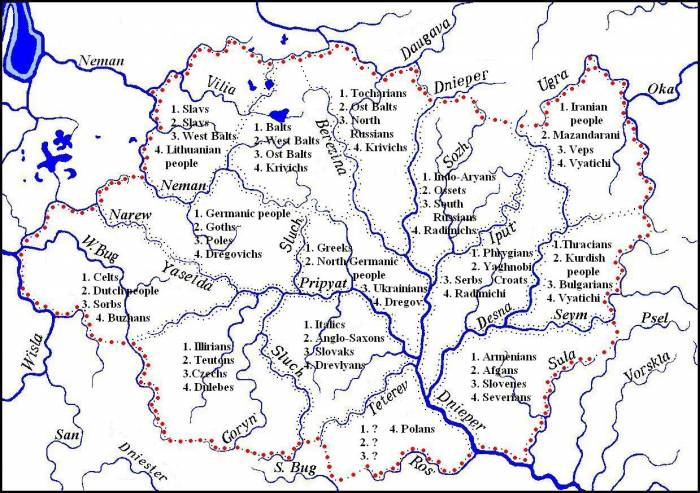
Ethno-Generating Areas
Third Alternative linguistics postulate based on the assumption that there is an inverse proportional relationship between the amount of common features in the language pair and the distance between the areas, which on were formed of these languages.
The newest interdisciplinary researches on the osculation of humanities and natural sciences put under the theoretical base for the application of the study by means of the graphic-analytical method. The impulse to the new approach to such researches was given by the work of B. B. Mandelbrot “The Fractal Geometry of Nature”(MANDELBROT B. B, 1982.) where the author has introduced in scientific employment the category of the fractal. This term characterizes a geometrical figure composed by parts which are similar to this figure. Using the category of the fractal in synergetic natural systems, Czech scientist Radan Květ substantiates the theory of four joined nets in the nature:
- the net of geological fault lines;
- the hydrological net;
- the net of prehistoric paths;
- the information net.
The essence of this theory is such. The faults of Earth's crust and specially the fault zones with inclination from highest points to the sea level conditioned the configuration of the hydrological net of water streams. Mainly on the first benches along rivers, footpaths were put by man absolutely unintentionally, and the net of prehistoric paths was simultaneously the primary information net. This net promoted the widening of technological experience, world-view ideas, artistic tastes etc (KVĚT R., 1998, 43, KVĚT RADAN. 2000,294.) It is clear that new words corresponding to new conceptions were widened together with the widening of experiences and ideas. However one has to bear in mind that the hydrological net is very discrete and water streams can as assist to the human intercourse as to prevent this. Little rivers and footpaths along them form local areas of human intercourse which can be limited by large river as hard to overcome obstacles for the widening of new information. Thus human communities joined by common language (dialect) and common cultural tradition were arisen in certain such areas. The geographical peculiarities of these areas resulted that the making of new ethnic communities can eventuate on them more than once. Therefore they cam be called the ethno-generating areas. However the primary ethnic communities arisen on the ethno-generating areas did not lose the intercourse with such adjacent ones, though the information exchange ran less intensive as inside of the area. While uprising of ethnic consciousness, conditioned by feeling of the difference in languages and cultures of primary ethnic communities, the process of their separation already goes knowingly, when people on the opposed bank of the river are perceived as other or strange ones. The river itself becomes not only a natural frontier but also as a psychological border between ethnic communities. Having in mind fractal construction of Earth’s surface, one can purpose that totality of next ethnic communities may to differ from another such totality in more large degree as ethnic communities inside totality. It is clear that natural frontiers can be not only large rives but also mountain chains, big forests, swamps etc.
Making out primeval ethnic communities is impossible without the self-perceiving of such community by its members. However this self-perceiving is impossible without common language. The role of geographic environment in making the primeval ethnic communities was emphasized already in 1940 by Jaromír Korčak:
Tribal belonging is a basic and objective characteristic of people as it contains full geographic and genetic interconnection. Social organization which leads to common language and culture arises only in this interconnection… It is obvious that people originality is impossible to hold without peculiar soul atmosphere communicated by own language .(JAROMÍR KORČAK, 1940, 6.)
Tribe arises from a consolidation of tribal communities with a tendency towards endogamy(BROMLEY Y.V., 1986, 431). This trend contributes to the fact that certain anthropological traits were fixed and spread in different tribes. one or several tribes constituting one ethnic community. One or several tribes constituting one ethnic community can populate one habitat. Geographical features of the habitat (mainly natural boundaries) influence the association of separate ethnic foci in only community with distinct linguistic, cultural and social peculiarities. Such a process in these habitats may occur more than once, so they can be called ethno-generating areas.
Map of Ethno-generating areas in Eastern Europe illustrating alternation of substratum influences.
At different time parent languages were separated in dialects which later developed in individual languages on the same areas. Prent-day names of people were given their ancestors. Number on areals corresponds such periods: 1. Uprising Indo-European languages 2. Uprising of Germanic and Iranian languages. 3. Formation of Slavic languages. 4. East Slavic tribes at the time of Kiev Rus'.
At different time parent languages were separated in dialects which later developed in individual languages on the same areas. Prent-day names of people were given their ancestors. Number on areals corresponds such periods: 1. Uprising Indo-European languages 2. Uprising of Germanic and Iranian languages. 3. Formation of Slavic languages. 4. East Slavic tribes at the time of Kiev Rus'.












